High Frequency Circuit Simulator
Nexxim™ is a circuit simulation tool that combined with Ansoft Designer™ targets the next generation of analog/mixed signal applications, including high performance RFCMOS, GaAs/SiGe RF ICs and gigabit computer and communication backplanes. With a multitude of algorithmic innovations in transient and harmonic-balance analyses, Nexxim achieves robust convergence and simulation speeds while improving accuracy and dynamic range. Nexxim addresses a major industry concern by running frequency and time-domain analyses using the same circuit netlist and the same library models, thus guaranteeing consistent results from two different domains.
Ansoft Corp.,
Pittsburgh, PA
(412) 261-3200,
www.ansoft.com.
13 GHz Oscilloscope
The Infiniium DS081304A oscilloscope provides 13 GHz, real-time bandwidth, which translates into higher signal fidelity, more accurate and repeatable measurements, and improved test margins. This instrument also allows previously hidden high speed signal components to be seen. The DS080000 series instruments have included the Infinimax II series probing system that is based on the InfiniiMax probing architecture. This makes it possible to measure 13 GHz signals from the high impedance probe tip to the highly responsive oscilloscope display. Price of this model is $122,500; 1169A 12/13 GHz Infiniimax II probe amplifier is $9000.
Agilent Technologies Inc.,
Santa Clara, CA
(800) 829-4444,
www.agilent.com.
LTCC Simulation and Optimization Tool
The LINMIC design suite linear is the new entry level to the LINMIC design suite. It offers integrated tools for efficient EM-based simulation, design optimization and layout of linear distributed RF and microwave circuits such as couplers, filters and matching networks. Optional extensions include nonlinear and multilayer circuit simulation/optimization and active device modeling. LINMIC LTCC is a new compact simulation and optimization tool for the design of multiplayer components like LTCC inductors, baluns or multilayer laminate components. It is based on a partial element equivalent circuit (PEEC) approach and therefore offers high computation speed compared to 3D planar or even full 3D simulators. Results are n-port S-parameters and a SPICE netlist, both for export to circuit simulators. Both tools are available as demo versions for download at www.linmic.com.
AC Microwave GmbH,
Aachen, Germany
+49 241 879 3022,
www.linmic.com.
Analog and RFIC Design System
Analog Office™ 2004 is a software tool for analog and radio-frequency integrated circuit (RFIC) designs. This version is an IC design system that is specifically architected and optimized for designers of analog and RFICs. It has been enhanced to provide an open, unified design environment, offering full interaction with a comprehensive and powerful set of integrated tools. The Analog Office 2004 toolset spans the entire IC design flow, from system-level to circuit-level design and verification, for complete top-to-bottom and front-to-back high frequency design. It supports the Linux platform, a significant extension of the AWR intelligent Net™ (iNet) technology to handle arbitrary layout geometries; automatic and “on the fly” connectivity extraction in layout; support for Verilog-A analog behavioral language; integration of an additional SPICE circuit simulator and electromagnetic (EM) simulators; and support for industry standard physical verification flow for final chip tape-outs.
Applied Wave Research Inc.,
El Segundo, CA
(310) 726-3000,
www.mwoffice.com
Self-contained Simulator for RF Conducted Immunity Testing
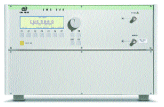 The CWS500D compact simulator is suited for ISO 11452-4, SAE J1113-4 and GMW3097 BCI testing. It is also used for testing to the avionics specification DO-160 conducted susceptibility test. It is capable of testing to the highest levels of the DO-160 spec. that are categories R, S, T, W and Y. The simulator includes the signal generator, bi-directional coupler, power amplifier, 3-channel power meter, controller and Windows-based operating software. Selecting the standard to be tested is sufficient to perform both calibration and testing. A complete test report is available, which can be exported to an RTF file or Excel for editing.
The CWS500D compact simulator is suited for ISO 11452-4, SAE J1113-4 and GMW3097 BCI testing. It is also used for testing to the avionics specification DO-160 conducted susceptibility test. It is capable of testing to the highest levels of the DO-160 spec. that are categories R, S, T, W and Y. The simulator includes the signal generator, bi-directional coupler, power amplifier, 3-channel power meter, controller and Windows-based operating software. Selecting the standard to be tested is sufficient to perform both calibration and testing. A complete test report is available, which can be exported to an RTF file or Excel for editing.
AR Worldwide,
Souderton, PA
(215) 723-8181,
www.arworldwide.com.
 Wafer Probe Stations
Wafer Probe Stations
The S300 wafer probe stations for 300 mm wafer probing and summit 1200 series probe stations integrate with the Agilent 4100 series, or integrated parametric analysis and characterization environment (iPACE). The 4100 series uses advanced switching matrix technology and supports a new atto sense and switch unit (ASU) that enables automation of parametric instruments without compromising measurement performance. The integration of these capabilities into one product allows the semiconductor industry to speed wafer characterization and lower the cost of testing, while enhancing test flexibility and performance. The atto sense mount allows easy integration with the new parametric analyzer. The S300 and summit series probe stations provide a complete measurement environment for on-wafer parametric tests.
Cascade Microtech Inc.,
Beaverton, OR
(503) 550-3279,
www.cascademicrotech.com.
EM Field Solver
An electromagnetic field solver FEKO for the Intel® extended memory 64 technology (EM64T) is available. EM64T is an enhancement to Intel’s IA-32 architecture allowing the processor to run 64-bit code and access larger amounts of memory. The main advantage being that it supports both 32- and 64-bit applications, with the result that all the components of FEKO can run on the same system, with the kernel accessing more than 2 Gbytes of memory, thereby increasing the number of unknowns that can be solved for Incore. Also, native 64-bit versions of the kernel for EM64T are available for both Linux and Microsoft Windows 64-bit edition (Windows XP or Server 2003).
EM Software & Systems-SA (Pty) Ltd.,
Stellenbosch, South Africa
+27 (21) 880 1880,
www.emss.co.za.
Process Design Kit
A new process design kit (PDK) supports Agilent’s RF design environment (RFDE) electronic design automation (EDA) software. It contains the full frequency range for its 0.18-micron mixed-signal/RF CMOS processes, from DC through baseband and into the RF range. This broad frequency range allows designers to simulate the entire system-on-chip design, ensuring correct operation at all frequencies. At the 0.18-micron node, these frequencies typically range from the audio and video frequencies in the baseband to 5 GHz in the RF band.
Magnachip Semiconductor,
Korea
82-43-270-2102,
www.magnachip.com.
MATLAB Programmer Productivity Tools
MATLAB® 7 is a new release that enhances programmer productivity with new tools that enable rapid, iterative program creation. In addition, MATLAB 7 offers built-in support for integer and single-precision floating-point math, as well as language features for managing and analyzing larger data sets. A large number of optimizations across data types, operations, functions and hardware result in improved computational performance of end user applications. Also new in the MATLAB family of products is an enhanced MATLAB compiler that now supports the full MATLAB language, enabling developers to deploy many more MATLAB applications for use outside of MATLAB.
The MathWorks Inc.,
Natick, MA
(508) 647-7427,
www.mathworks.com.
Radar/Microwave Monitoring Receiver
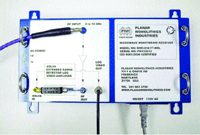 The RMR-818-77-NRL is an 8.0 to 18.0 GHz radar/microwave monitoring receiver for labo-ratory applications. The receiver uses an extended range detector log video amplifier (DLVA), a preamplifier and RF bandpass filtering. It also has a dynamic range of 75 dB with a typical TSS of –80 dBm. It can be supplied with either individually removable bandpass filters or various switched filter bank options. The basic model offers a log video output for analysis through external equipment. These microwave monitoring receivers are available in frequency ranges from 0.5 to 20.0 GHz.
The RMR-818-77-NRL is an 8.0 to 18.0 GHz radar/microwave monitoring receiver for labo-ratory applications. The receiver uses an extended range detector log video amplifier (DLVA), a preamplifier and RF bandpass filtering. It also has a dynamic range of 75 dB with a typical TSS of –80 dBm. It can be supplied with either individually removable bandpass filters or various switched filter bank options. The basic model offers a log video output for analysis through external equipment. These microwave monitoring receivers are available in frequency ranges from 0.5 to 20.0 GHz.
Planar Monolithics Industries Inc.,
Frederick, MD
(301) 631-1579,
www.planarmonolithics.com.
 Dual-band Signal Strength Measurement System
Dual-band Signal Strength Measurement System
This system is available in either AMP/PCS (310-010062-001) or GSM/DCS (310-010062-001) configuration. This easy to use system is ideal for making path loss measurements. The dual-band test set includes the receiver with portable antenna, transmitter, cable and adapters, as well as an inline attenuator for setting the transmitter output power using the receiver. The transmitter and receiver are also available separately. The receiver can be connected to a PC to log signal level data. The receiver is also compatible with Wireless Valley’s Infielder“ software. The system is packaged in a foam-lined case suitable for use as a shipping container.
Praxsym Inc.,
Fisher, IL
(217) 897-1744,
www.praxsym.com
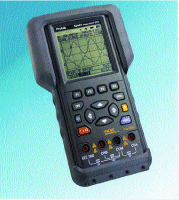 Hand-held 5 MHz DSO/DMM
Hand-held 5 MHz DSO/DMM
Model S2405 is a battery operated, lightweight, dual channel multifunction DSO/DMM. It has a 5 MHz bandwidth, 50 MS/s sampling rate (single) and 50 mV sensitivity. This portable scope/ meter has a DSO section that features an 8-bit resolution with a record length of 512 bytes for single shot/glitch capture along with 256 bytes for other modes. It is capable of saving up to 16 waveforms and setups in memory, and its vertical sensitivity ranges from 50 mV in 1-2-5 order with 600 VDC or AC RMS maximum input voltage. Standard equipment includes an RS232 port with software. Selling price for the S2405 is $399 (US) list. It is complete with a 4.8 V NiMh battery pack with a 120 V to 9 V at 1 Amp DC battery, both standard, RS 232 cable, software, test leads, holster, AC/DC charger and carrying case. Weight is 1.5 lbs and size is 3.5 × 7.5 × 1.57".
Protek,
Allendale, NJ
(201) 760-9898,
www.protektest.com.
 WCDMA Base Station Tester
WCDMA Base Station Tester
The FSMU-W combines the vector signal generator SMU200A with the vector signal analyz- er FSQ. Preconfigured for WCDMA, with one RF path and an analyzer frequency range up to 26 GHz, both instruments together test WCDMA base stations in line with the 3GPP standard. The FSMU-W can be upgraded at any time with a second RF path, a fading simulator and options for other 2G or 3G standards.
Rohde & Schwarz,
Munich, Germany
+49 89 4129-13779,
www.zvb.rohde-schwarz.com.
Components
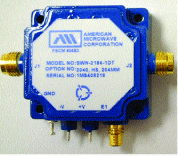 100 kHz to 40 GHz Solid State Switch
100 kHz to 40 GHz Solid State Switch
This single-pole single-throw solid-state switch features high speed, high isolation and very broad band. The frequency range is 100 kHz to 40 GHz and useful operation can be obtained to 50 GHz. Over this bandwidth the isolation is greater than 60 dB, while switching speed delay is less than 7 ns and the rise and fall times are less than 5 ns.
American Microwave Corp.,
Frederick, MD
(301) 662-4700,
www.americanmicrowavecorp.com.
 DC to 2.5 GHz 2 W SMA Attenuators
DC to 2.5 GHz 2 W SMA Attenuators
The 660 series SMA coaxial attenuators cover all commercial wireless bands from DC to 2.5 GHz and are available in attenuation values from 0 to 40 dB in 1 dB increments. Standard attenuation values of 3, 6, 10 and 20 dB are in stock. These attenuators dissipate 2 W max. average RF/microwave power (500 W peak), and feature gold-plated brass connectors and contact pins and virgin electrical grade PTFE insulation within the connectors.
MECA Electronics,
Denville, NJ
(973) 625-0661,
www.e-meca.com.
 Miniaturized SAW Filters
Miniaturized SAW Filters
Two new product families are available in CSSP3 (third-generation chip-size SAW package) technology. Product family 1411 has a footprint of 1.4 × 1.1 mm and an insertion height of 0.4 mm. It supersedes current standard 2014. The second product family, 1513, has a footprint of 1.5 × 1.3 mm and an insertion height of less than 0.6 mm. It supersedes the current standard 2016.
EPCOS UK Ltd.,
Berkshire, England
+44(0) 1344 396689,
www.epcos.com.
 DC to 6 GHz Fixed Attenuator
DC to 6 GHz Fixed Attenuator
This miniature low cost fixed attenuator operates from DC to 6 GHz. It has a HEX body and offers excellent VSWR, good attenuation accuracy and a wide operating temperature range of -65° to +125°C. It is capable of handling 2 W average power.
JFW Industries Inc.,
Indianapolis, IN
(317) 887-1340,
www.jfwindustries.com.
 1 GHz to 10 GHz High Pass Filter
1 GHz to 10 GHz High Pass Filter
Utilizing suspended substrate technology, this filter's (p/n 9SH10-1000/T10000-0/0) passband performance holds out to 10X the cut-off frequency. Other specifications include 3.0 dB cut-off at 1.0 GHz, insertion loss: <1.0 dB at 1.1 GHz to 10 GHz, stopband: >50 dB at DC to 0.5 GHz and VSWR: 2.0 at 1.1 GHz to 10 GHz. The package size is 1.3 ¥ 1.0 ¥ 0.5".erature is 20° to 65°C. Size is 0.5" ¥ 0.7" ¥ 0.5". Price is $1300 ea.
K&L Microwave Inc.,
Salisbury, MD
(410) 749-2424,
www.klmicrowave.com.
 Dual-band Surface-mount Diplexer
Dual-band Surface-mount Diplexer
The model 3DP9-1227/1575-M is a GPS dual-band diplexer. The filter provides a 0.5 dB relative bandwidth over the center 30 MHz, with 1.5 VSWR over the pass band. The 3 dB bandwidths are 100 MHz typical. The insertion loss at center frequency is 1.2 dB (low band) and 1.65 dB (high band) max. The physical size is 1.25 × 0.5 × 0.38".
Lorch Microwave,
Salisbury, MD
(410) 860-5100,
www.lorch.com.
High Precision RF and Microwave Connectors
These high precision 7/16 RF and microwave connectors feature super low passive intermodulation (PIM). Configurations include type NF and SMA connectors, which are in stock and available for quick delivery.
Microwave Communications
Laboratories Inc.,
Saint Petersburg, FL
(727) 344-6254,
www.mcli.com.
 Reciprocal X-band Ferrite Switch
Reciprocal X-band Ferrite Switch
The Tandem-rotator Reciprocal ferrite switch uses 0° and 90° total Faraday rotation states to achieve reciprocal connections to the desired ports. This structure operates at moderate isolation and power levels (peak and average) compared to bridge-switches, but is smaller and less expensive. It operates from 8.5 to 9.5 GHz, peak power is 50 kW, average power is 100 W, isolation is 25 dB, insertion loss is 0.5 dB, return loss is 17.7 dB, switching speed is < 25 ms, operating temperature is -30° to +60°C and weight is 1.6 lbs.
Microwave Applications Group,
Santa Maria, CA
(805) 928-5711,
www.magsmx.com.
 Surface-mount Relay
Surface-mount Relay
The GRF172 Centigrid“ surface-mount relay is an ultraminiature hermetically sealed armature relay for 2.5 GHz applications. Its low profile height (0.330") and 0.100" grid-spaced terminals make it suitable for extreme packaging density and close PC board spacing. The ground shield feature isolates and shields each lead providing an insertion loss of < 0.3 dB, a VSWR of 1.10 and a pole-to-pole isolation of 45 dB. It is available with a choice of DC coils, DPDT contacts and an optional coil transient suppression diode.
Teledyne Electronics and Communications,
Quickborn, Germany
+49 (0) 4106 7684-0,
www.teledyne-europe.com.
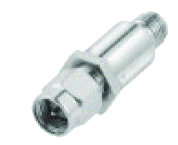 DC Block to 18 GHz
DC Block to 18 GHz
These coaxial BLK-18 DC blocks operate from 10 MHz to 18 GHz and provide very low inser- tion loss (less than 1.0 dB up to 18 GHz) and a return loss of 24 dB typical. The units have SMA (F) to SMA (M) connectors and are 1.18" long. They operate from -55° to 100°C. Pricing is $21.95 ea. in 1 to 9 piece quantity.
Mini-Circuits,
Brooklyn, NY
(718) 934-4500,
www.minicircuits.com.
 Detector/Coupler/Switch
Detector/Coupler/Switch
he model TDCS-4T-10F-HP is an integrated threshold detector, 17 dB coupler and a SPDT PIN diode switch. The device operates from 9 to 10.5 GHz (other frequency ranges are available), with an insertion loss of 2 dB maximum, VSWR of 1.5 maximum, 2 W average RF input power handling capability and TTL threshold output. The TDCS-4T-10F-HP is designed to operate in harsh environments with stability over temperature and frequency. Size: 1.5 × 1.2 × 0.40".
Planar Monolithics Industries,
Frederick, MD
(301) 662-4700,
www.planarmonolithics.com.
 New BNC Connector Material
New BNC Connector Material
A right angle circuit board BNC jack connector manufactured using a metal molded technology – Zamak – has been introduced. Available with an impedance of 50 W, the Zamak BNC connector features a very low return loss of 28 db at up to 1.5 GHz. These connectors are also highly solderable through selective tin plating on the legs and the center contact. Exhibiting the same electrical and mechanical performance as the standard material units, they are less expensive.
Radiall,
Rosny Sous Bois, France
33 1 49 35 35 35,
www.radiall.com.
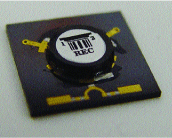 WiFi Surface-mount Isolators/Circulators
WiFi Surface-mount Isolators/Circulators
Model 2W6NB is a surface-mount microstrip isolator designed for WiFi IEEE 802.11a wireless-local-area-network (WLAN) applications operating from 5.15 to 5.35 GHz. It occupies a footprint of 12 × 12 mm and is for use in PCMCIA cards. The isolator has port-to-port isolation of 17 dB with an insertion loss of 0.4 dB. It is designed to handle power levels to 1 W and exhibits a VSWR of 1.3. Circulator versions and frequencies of 2.4 GHz are also available. Price is less than $5.00 in large production quantities.
Renaissance Electronics Corp.,
Harvard, MA
(978) 772-7774,
www.rec-usa.com.
 Surface-mount Lumped Element Isolator
Surface-mount Lumped Element Isolator
The RLEI series is a surface-mount lumped element isolator that covers 19 specific frequencies ranging from 800 to 2500 MHz. This isolator is designed for tape and reel high speed applications for high volume projects. This low cost unit is 5 mm square and is supplied at 2000 pieces per reel.
Raditek,
San Jose, CA
(408) 266-7404,
www.raditek.com.
 200 to 2000 MHzBi-directional Coupler
200 to 2000 MHzBi-directional Coupler
The model C6600 is a low loss, bi-directional 20 dB coupler that covers the entire 200 to 2000 MHz frequency band. It is rated at 200 W CW, with an insertion loss of 0.25 dB, VSWR of 1.2 and directivity of 20 dB. It is suitable for both military and commercial applications.
Werlatone Inc.,
Brewster, NY
(845) 279-6187,
www.werlatone.com.
 DC to 6 GHz SMA Attenuator
DC to 6 GHz SMA Attenuator
Model 2082-6346-XX is a fixed passivated stainless steel attenuator with gold plated beryllium copper center conductor. It covers the frequency range of DC to 6 GHz with standard attenuation of 0 to 12, 15, 20 and 30 dB. VSWR is 1.15 up to 2.5 GHz and 1.35 at the high end. Power handling is 2 W average and 200 W peak. Operating temperature is -65° to +125°C. Length is 0.86" and weight is 0.21 oz. Price for 1 to 99 pieces is $11.99 each.
XMA Corp.,
Manchester, NH
(603) 222-2256,
www.xmacorp.com.
Amplifiers
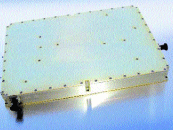 Broadband RF Power Amplifier
Broadband RF Power Amplifier
Part number SSPA 0.4-2.2-10 is a high power broadband amplifier that operates from 0.4 to 2.2 GHz. It is packaged in a modular housing that is approximately 6.5 × 10.0 × 1.0". The minimum output power at P1dB is 10 W at room temperature; saturated power is 20 W across the band; small signal gain is 45 dB typical; input VSWR is 2.0 typical and output VSWR is 3.0 worst case.
Aethercomm Inc.,
San Marcos, CA
(760) 598-4340,
www.aethercomm.com.
 Wideband Cascadable Gain Block Outputs +24 dBm
Wideband Cascadable Gain Block Outputs +24 dBm
The high linearity HMC482ST89 SiGe HBT MMIC amplifier covers the frequency range of DC to 5 GHz. This gain block is fully matched to 50 W, provides 19 db of gain and can be used as a cascadable gain stage in various RF and IF applications. With +22 dBm of output P1dB and +36 dBm of output IP3 at 1 GHz, this unit can be also used as an LO buffer amplifier or as a PA pre-driver. It consumes 110mA from a single positive supply of +6 V and requires no matching components. It is housed in an industry standard SOT89 surface-mount package.
Hittite Microwave Corp.,
Chelmsford, MA
(978) 250-3343,
www.hittite.com.
 17 to 35 GHz MMIC Low Noise Amplifier
17 to 35 GHz MMIC Low Noise Amplifier
The XL1001 is a self-biased , MMIC two-stage low noise amplifier that covers 17 to 35 GHz. It has a small signal gain of 14 dB with a noise figure of 2.5 dB across the band. It includes simple, single supply bias with no need for negative voltages or active bias circuits. Due to its balanced design it has good input and output matches. It is suited for wireless communications such as millimeter-wave point-to-point radio, local multipoint distribution services (LMDS) and SATCOM.
SMimix Broadband Inc.,
Houston, TX
(281) 988-4600,
www.mimixbroadband.com.
Ultra Wideband Low Noise Amplifier
This LNA, part number AF00120243A, covers the entire frequency range of 0.1 to 20.0 GHz with a single unit; minimum gain is 24 dB, maximum noise figure is 3.0 and maximum gain flatness is ±1.5 dB. Bias is +5 V at 90mA. Both connectorized and drop-in versions are available.
Herotek Inc.,
San Jose, CA
(408) 941-8399,
www.herotek.com.
 Ultra Low Noise Amplifier
Ultra Low Noise Amplifier
Model PE2-30-610-1R2-15-SFF LNA operates from 6 to 10 GHz with a typical noise figure of 0.8 dB, 1.2 dB maximum. The gain is 30 db, VSWR in/out is 1.75, power output at 1 dB compression point is 2 dBm and gain flatness is ±0.75 dB. Bias levels are 15 V at 45 mA.
Planar Electronics Technology,
Frederick, MD
(301) 662-5019,
www.planarelectronicstechnology.com.
Dual-band UMTS Power Amplifier Module
The TQM7M60001 is a dual-band UMTS power amplifier module in a small 4 × 4 × 1.1 mm form factor. It is designed to support cost-effective GSM, EDGE, UMTS and HSDPA (high speed download packet access) compressed mode phone architectures with only one antenna. Its biasing circuit is optimized for low idle current consumption (below 30 mA). The output power is 27.5 dBm with a linearity that provides a 7 dB margin for the UMTS ETSI requirement. This allows sufficient margin for applying additional transmit channels for large-scale data transmission rates, enabling next generation 3G phones for HSDPA.
TriQuint,
Hillsboro, OR
(503) 615-9000,
www.triquint.com
Power Amplifier Module
The ECM168 is a 1.9 GHz high efficiency power amplifier module utilizing InGaP HBT technology. It has 33.5 dBm output power, a single 10 to 12 V supply, 33 dB typical gain and a good ACPR2 at 600 kHz offset. The device operates over a frequency range of 1800 to 1920 MHz. No negative voltage is required and the efficiency is 20%. It is housed in a flange mount package measuring 29 × 13 × 4 mm.
WJ Communications Inc.,
San Jose, CA
(408) 577-6200,
www.wj.com.
Devices
High Q, Low Cap Ceramic Trimmer Capacitor
The model 0538-099A0.8-20 is a ceramic trimmer capacitor that exhibits high Q and a capacitance as low as 0.8 pF. It is 0.375" in diameter and 0.275" high, operates effectively at –55° to +125°C with a torque resistance of 1.0 to 6.0 oz-ins. The silver electrodes are intimately bonded to the top surfaces of the base rotor. The terminals and other metal parts are nonferrous and silver-plated to provide excellent conductivity and trouble free soldering.
Tusonix,
Tucson, AZ
(520) 744-0400,
www.tusonix.com.
 Zero Bias SMT Schottky Diodes
Zero Bias SMT Schottky Diodes
The MA4E2200 zero bias surface-mount Schottky diode series is silicon medium barrier devices offered in JEDEC SOD-323, SOT-23 and SOT-143 plastic packages. They are manufactured using a planar-BCB foundry process and are offered in single, single tee, series tee reverse and unconnected pair configurations. They are suitable for circuits requiring lower tangential sensitivity (TSS) values as in RF envelope detection with temperature compensation, as well as in limiter circuits where lower flat leakage power is required (Z +10 dBm). They can operate from DC to 4 GHz and up to a peak RF incident power of +20 dBm. Pricing is $0.17 for the SOD-323, $0.21 for the SOT-33 and $0.23 for the SOT-143 packages.
M/A-COM Inc.,
Lowell, MA
(800) 366-2266,
www.macom.com/microwave_ic_products.
 Ring Quad Schottky Surface-mount Ceramic Package
Ring Quad Schottky Surface-mount Ceramic Package
These low, medium and high barrier Schottky ring quads are manufactured using an in-house epitaxial process. The CS-17 are square ceramic surface-mount packages with an epoxy top. The dimensions are 0.06 × 0.06 × 0.025" with four bonding pads on the bottom, making them suitable for high volume manufacturing. They are available in "sleeves" or tape and reel. The monolithic design makes them useful for double balanced mixers, modulators and doublers.
Micrometrics Inc.,
Londonderry, NH
(603) 641-3800,
www.micrometrics.com.
2.4 GHz Transceiver Chip
 The nRF24Z1 is a single chip 2.4 GHz 4 Mbit/s solution for CD-quality wireless audio streaming with extremely low latency. It uses the company's latest 4 Mbit/s MegaZtream™! platform embedding a state of the art quality of service subsystem with an ultra low power robust 4 Mbit/s wireless 2.4 GHz transceiver and all appropriate digital audio interfaces to create a complete digital wireless streamer solution in a 6 × 6 mm package. This configuration ensures that there is bandwidth enough to stream and transmit 16-bit 48 Kspls/s CD quality audio without using compression. In addition to streaming audio the chip also boasts a digital control information channel for transfer of control information such as volume, balance, track and display information.
The nRF24Z1 is a single chip 2.4 GHz 4 Mbit/s solution for CD-quality wireless audio streaming with extremely low latency. It uses the company's latest 4 Mbit/s MegaZtream™! platform embedding a state of the art quality of service subsystem with an ultra low power robust 4 Mbit/s wireless 2.4 GHz transceiver and all appropriate digital audio interfaces to create a complete digital wireless streamer solution in a 6 × 6 mm package. This configuration ensures that there is bandwidth enough to stream and transmit 16-bit 48 Kspls/s CD quality audio without using compression. In addition to streaming audio the chip also boasts a digital control information channel for transfer of control information such as volume, balance, track and display information.
Nordic Semiconductor ASA,
Oslo, Norway
+47 22 51 10 50,
www.nordicsemi.no.
Sources
Low Noise PLOs
Operating at fixed frequencies in the 300 MHz to 22 GHz range, the APL-02 series of fundamental frequency phase-locked oscillators provides a low noise and stable local oscillator input for frequency converters for multiple uses. The compact oscillators are either coaxial resonator based for frequencies up to 3.0 GHz, using low noise silicon bipolar active devices or dielectric resonator based for frequencies above 3.0 GHz, using GaAs FETs or MMICs. The use of fundamental frequency architecture drives down phase noise and minimizes physical size. For example, a 4 GHz unit achieves considerably better than –110 dBc/Hz phase noise at 10 kHz offset from the carrier with a typical floor close to –140 dBc/Hz. Using an internal reference the “close in” phase noise is better that –64 dBc/Hz at 100 Hz offset and can be improved further by the use of an external ultra low phase noise OCXO reference.
Atlantic Microwave Ltd.,
Braintree Essex, UK
+44 00 1376 550220,
www.atlanticmicrowave.co.uk.
 Low Power OCXO
Low Power OCXO
Part 1412 is an AT cut crystal oscillator with a sine wave output. It requires 175 mW at a sup- ply voltage of 5 V and at 0° to 50°C exhibits stabilities down to 15 ppb. Frequencies available are 10, 16, 19.44 and 20 MHz. Packaging is European standard and it measures 36.0 × 27.2 × 19.0 mm. Pricing is $90.00 ea. in quantities of 100 pcs.
ILSI America,
Reno, NV
(775) 851-8880,
www.ilsiamerica.com.
PECL VCXOs to 300 MHz
PECL (positive emitter coupled logic) voltage-controlled oscillators (VCXO) are available with frequency ranges up to 300 MHz. They utilize inverted mesa and AT strip crystals to achieve pull ranges of up to ±200 ppm at 300 MHz, operating in the fundamental mode, and provide a low jitter in the 2 to 5 nanosecond range. When ordered with an extended operating temperature range they can operate in temperatures of –55° to +125°C. Operating voltages are 5 V, 3.3 V or 3 V. Size is 5 ¥ 7 ¥ 1.5 mm. Pricing is $12.00 ea. in quantities of 1000 pcs.
MMD Components (Monitor & Quartztek),
Rancho Santa Margarita, CA
(949) 709-5075,
www.mmdcomp.com.
 Low Phase Noise MMIC VCOs
Low Phase Noise MMIC VCOs
This new line of GaAs monolithic microwave integrated circuit VCOs with integrated buffers covers the 4.8 to 12 GHz frequency range in several bands. It delivers more than 10 dBm of output power and exhibits outstanding phase noise behavior. These HBT MMICs integrate an active device, resonator, varactor and buffer amplifier on a chip, thus no external elements are necessary. All VCOs are housed in a standard 4 × 4 mm QFN plastic package and provide identical footprint assignments.
Work Microwave GmbH,
Holzkirchen, Germany
+49 8024 64080,
www.work-gmbh.de.
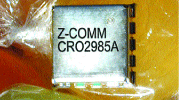 Low Cost Coaxial
Low Cost Coaxial
Resonator VCO The coaxial resonator VCO, model CRO2985A, covers 2955 to 3014 MHz in 0.5 to 4.5 V of tuning. It delivers a clean spectral signal of -82 and -110 dBc/Hz at 1 and 10 kHz offsets, respectively, while covering the 59 MHz bandwidth with an average tuning sensitivity of 22 MHz/V. The CRO2985A is designed to operate off a 5 V supply while drawing 20 mA of current, and provides 6±3 dBm of output power into a 50 W load over the temperature range of -40° to +85°C. It suppresses the 2nd harmonic to better than -15 dBc and is further heightened by pushing less than 1 MHz within 5 percent of the nominal supply voltage and pulling less than 1 MHz with a 14 dB return loss, any phase. Size is 0.5 × 0.5 × 0.22".
Z-Communications Inc.,
San Diego, CA
(858) 621-2700,
www.zcomm.com.
RF Transceiver
The MICRF505 transceiver operates from 850 to 950 MHz, and supports frequency-shift keyed (FSK) modulation at data rates up to 200 kbps. Many functions are user programmable, including the frequency synthesizer, making the MICRF505 ideal for frequency hopping applications. It is 5 ¥ 5 mm and is designed to accommodate low cost, low accuracy crystals. To address this, a frequency error estimator has been added to determine frequency mismatch between communicating transceivers and an internal crystal tuning mechanism to enable automated crystal tuning on-the-fly. It also incorporates an internal clock recovery circuit to reduce the burden on its companion baseband device enabling the use of a lower cost microcontroller. Prices start at $4.50.
Micrel Inc.,
San Jose, CA
(408) 944-0800,
www.micrel.com.
Transceivers for Cellular Radios
These POLARIS 2 transceivers are designed using direct digital polar architecture and support up to four frequency bands (850, 900, 1800 and 1900 MHz). They perform all the radio functions of GSM, GPRS and EDGE cellular handsets. The receive sensitivity is –109 dBm and –108 dBm in the low and high bands, respectively. The transceiver implements both very low IF (VLIF) and direct conversion receive (DCR) architecture and provides selectable analog I/Q and digital baseband interfaces. Additionally, VCOs and loop filters are integrated. Production pricing is $8.50 ea. in volumes of 100,000 units.
RF Micro Devices,
Greensboro, NC
(336) 664-1233,
www.rfmd.com.
Microwave Switch Platform
The 1260-67 M, six position, single-slot, VXI, modular, microwave switch platform allows users to specify up to twelve combinations of various 18 GHz and/or 26 GHz switches, enabling them to mix and match while keeping the size to a single VXI slot. The platform provides a choice of eight switch types, including 18 GHz and 26 GHz 1 × 2, multi-throw and transfer switches. This modular approach means there is no need to purchase separate C-size cards for each type of microwave switch needed in a system.
Racal Instruments Group Ltd.,
Wimborne Dorset, England, UK,
+44 (0) 1202 872800,
www.racalinstrumentsgroup.com.
PROCESSING EQUIPMENT
Laser PCB Prototype System
ProtoLaser 100 is an easy-to-operate high performance laser structuring system for printed circuit board prototyping that combines the milling, drilling and contour routing capabilities of an advanced LPKF Protomat® PCB plotter. The ProtoLaser 100 is ideal for producing high quality RF and microwave boards on a variety of materials from FR4 to PTFE-based substrates, as well as for structuring, cutting and drilling. A board can be structured at speeds up to 6 sq. cm (1 sq in.) per minute, producing circuit paths as small as 50 mm (2 mils).
LPKF Laser & Electronics,
Wilsonville, OR
(503) 454-4200,
www.lpkfusa.com.
